What is Analog Circuit Simulator
An analog circuit simulator is a software tool or program to analyze and predict the behavior of analog electronic circuits. It employs mathematical models and algorithms to simulate the performance of analog circuits accurately. By inputting circuit parameters and simulated input signals, an analog circuit simulator provides accurate signal outputs, allowing designers and engineers to evaluate the performance of their circuit designs before physical implementation.
Analog circuit simulators operate in different modes, including AC (frequency domain), DC (non-linear quiescent), and Transient (time-domain). In AC mode, the simulator analyzes the circuit’s frequency response, calculating gain, phase shift, and other characteristics at different frequencies. This mode is particularly useful for designing filters and amplifiers. In DC mode, the simulator analyzes the circuit’s behavior in a non-linear quiescent state, calculating voltages, currents, and power dissipation. This mode is useful for analyzing biasing and stability. In Transient mode, the simulator analyzes the circuit’s behavior over time, calculating time-varying voltages and currents, allowing designers to observe the circuit’s response to different input signals. This mode is useful for analyzing transient response and stability.
Analog circuit simulators use mathematical models and algorithms to represent the behavior of electronic components and interconnections accurately. These models can be linear or non-linear, depending on the circuit’s complexity and required simulation accuracy. Linear models assume the behavior of components and interconnections can be accurately described by linear equations, simplifying the simulation process. Non-linear models account for the non-linear behavior of components and interconnections, using more complex mathematical equations to accurately represent the circuit’s behavior.
Frequently Asked Questions
What Is Analog Circuit Simulation
Analog circuit simulation involves the utilization of precise models or representations of the electronic circuit to achieve a high level of accuracy. These models encompass non-linear, linear, and simpler table-based representations of the different electronic devices within the circuit. Analog simulation can be executed in various modes.
What Are the Two Types of Circuit Simulation
There are two primary circuit simulation methods: analog and digital. Analog simulation involves using continuous variables, such as voltage and current, to replicate the behavior of analog circuits. On the other hand, digital simulation utilizes discrete variables, such as logic levels and bits, to replicate the behavior of digital circuits.
What Is Simulation in PCB Design
Simulation in PCB design involves the use of mathematical models to accurately predict the behavior of printed circuit boards and electronic devices. By utilizing simulation software, designers can model the operation of electronic circuits, which ultimately enhances the efficiency of the design process by allowing for the evaluation of circuit behavior before physical manufacturing takes place.





